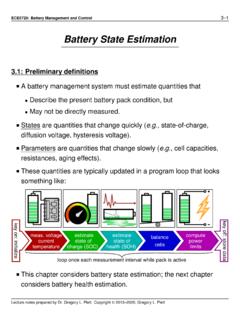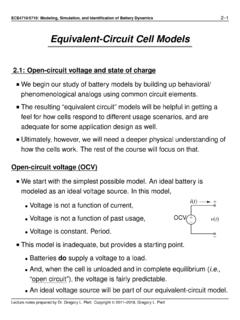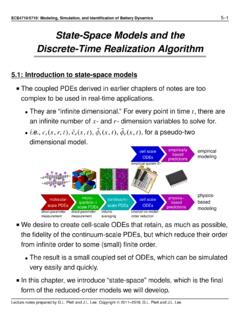Transcription of STATE-FEEDBACK CONTROL
1 ECE4520/5520: Multivariable CONTROL Systems 1 STATE-FEEDBACK : STATE-FEEDBACK CONTROL We are given a particular system having : We know that open-loop system poles are given by eigenvaluesofA. Want to use change the dynamics. Will assume the form oflinearstatefeedback with gain ! ; K2R1"n: We assume known exactly: then, we ; B; C; DxK ! ! : For now we talk about regulation ( ) notes prepared by Dr. Gregory L. Plett. Copyrightc#2015, 2011, 2009, 2007, 2005, 2003, 2001, 2000, Gregory L. PlettECE4520/5520, STATE-FEEDBACK CONTROL6 2 For now we consider SISO systems, and generalize :DesignKso thatACLDA!BKhas some nice example, PerhapsAis unstable. DesignACLto be stable. Or, might want to put two poles at!2 j.(Poleplacement.) There arenparameters in the gain vectorKandneigenvalues , what can we achieve?EXAMPLE:Consider the (unstable) "1112# "10# ! !1/.s!2/!1Ds2!3sC1: ! ! !BKD"1112#!"10#hk1k2iD"1!k11!k212#: So, ! !3 !
2 2k1Ck2/. By choosingk1andk2, the complexplane (in complex-conjugate pairs, that is!) For example, how can we place poles at!5;!6?Lecture notes prepared by Dr. Gregory L. Plett. Copyrightc#2015, 2011, 2009, 2007, 2005, 2003, 2001, 2000, Gregory L. PlettECE4520/5520, STATE-FEEDBACK CONTROL6 3 Compare desired closed-loop characteristic ! !3 !2k1Ck2/: So,k1!3D11;or;k1D141!2k1Ck2D30;or;k2D57: KD 14 57 . So, with thenparameters inK, $Most physical systems, qualified yes.$Mathematically, EMPHATIC NO! Boils down to whether or not the system is, ifevery internal system mode can be excited by inputs, either directly :Consider the "1102# "10# ! :ACLDA!BKD"1!k11!k202# ! !1Ck1/.s!2/: Feedback of the state cannot move the pole stabilized via state feedback. (Note that the system is already inKalman form, and the uncontrollable mode has eigenvalue 2).Lecture notes prepared by Dr. Gregory L. Plett. Copyrightc#2015, 2011, 2009, 2007, 2005, 2003, 2001, 2000, Gregory L.
3 PlettECE4520/5520, STATE-FEEDBACK CONTROL6 : Bass Gura pole placementFACT:IffA; Bgis controllable, then we can arbitrarily assign theeigenvalues ofACLusing state feedback. More precisely, given anypolynomialsnC 1sn!1C%%%C nthere exists a (unique for SISO)K2Rm"n(mDnumber of system inputsD1for SISO) such !ACBK/DsnC 1sn!1C%%%C n:COROLLARY:IffA; Bgis controllable, we can find a state feedback forwhich the closed-loop realization is OF FACT:We prove this by solving for the state feedback vectorKto put the poles where we desire. First, supposefA; Bgis controllable. To make a hard problem easier, we then transformfA; B; C; Dgintocontroller canonical form.(Then solve problem in this form, thenconvert back to original form). That is, findTsuch thatT!1 ATDAcD266664!a1!a2%%%!an10::::::0%%%1037 7775andT!1 BDBcD26666410 !A/DsnCa1sn!1C%%%Can.$We defer calculation ofTfor now. Let s apply state-feedbackKcto the controller notes prepared by Dr.
4 Gregory L. Plett. Copyrightc#2015, 2011, 2009, 2007, 2005, 2003, 2001, 2000, Gregory L. PlettECE4520/5520, STATE-FEEDBACK CONTROL6 5 Note,KcDhk1%%%kni,soBcKcD266664k1k2%%%kn 00::::::00377775: Useful because characteristic equation !BcKcD266664!.a1Ck1/!.a2Ck2/%%%!.anCkn/1 0::::::0%%%10377775;still in controller form! !a1!a2!a3!k1!k2!k3 Thus, after state feedback withKcthe characteristic equation ! !1C%%% :Lecture notes prepared by Dr. Gregory L. Plett. Copyrightc#2015, 2011, 2009, 2007, 2005, 2003, 2001, 2000, Gregory L. PlettECE4520/5520, STATE-FEEDBACK CONTROL6 6 The desired characteristic equation is" 1sn!1C%%%C n: Equating coefficients of powers-of-s,wesetk1D 1!a1;:::;knD n!anand get the desired characteristicpolynomial. Now that we have the solution in the controller canonical form, wetransform back to the original realization" ! ! !1 !TAcT!1 CTBcKcT!1 !ACBKcT!1/:". !ACBK/soKDKcT!1:So, if we use state feedbackKDKcT!1Dh.
5 1!a1/%%%. n!an/iT!1we will have the desired characteristic polynomial. One remaining question: What isT?WeknowTDCC!1candCcD2666641!a1a21!a2% %%01!a10:::1:::0%%%1377775 Lecture notes prepared by Dr. Gregory L. Plett. Copyrightc#2015, 2011, 2009, 2007, 2005, 2003, 2001, 2000, Gregory L. PlettECE4520/5520, STATE-FEEDBACK CONTROL6 7C!1cD2666641a1%%%an!101:::::::::a101377 775 ..upper ToeplitzT!1D2666641a1%%%an!101:::::::::a 101377775!1C!1 So,KDh. 1!a1/%%%. n!an/i2666641a1%%%an!101 an!2:::::::::01377775!1C!1: This is called theBass Gura notes prepared by Dr. Gregory L. Plett. Copyrightc#2015, 2011, 2009, 2007, 2005, 2003, 2001, 2000, Gregory L. PlettECE4520/5520, STATE-FEEDBACK CONTROL6 : Ackermann s formula We need to knowaito use the Bass Gura formula. Ackermann smethod may require less work. Consider (a system already in controller canonical form, fornow),".s/DsnCa1sn!1C%%%Cans0".Ac/DAnc Ca1An!1cC%%%CanID0by Cayley Hamilton. Also," 1sn!
6 1C%%%C ns0" 1An!1cC%%%C nI 0" !0D" !".Ac/D. 1!a1/An!1cC%%%C. n!an/I: Asneakyfactforthecontrollerformis,h0%%%1 iAkcDh0%%%1 ..n!k%%%0iso thath0%%%1i" 1!a1/. 2!a2/%%%. n!an/iDKcKcDh0%%%1i" : To convert to the original form,KDKcT!1Dh0%%%1i" !1AT /T!1Dh0%%%1iT!1" notes prepared by Dr. Gregory L. Plett. Copyrightc#2015, 2011, 2009, 2007, 2005, 2003, 2001, 2000, Gregory L. PlettECE4520/5520, STATE-FEEDBACK CONTROL6 9Dh0%%%1iCcC!1" !1" : Revisit previous example." "1101#KDh01i"1!101#("1112#"1112#C11"1112 #C30"1001#)Dh01i("2335#C"41 1111 52#)Dh01i"43 1414 57#Dh14 57i: same as before: K=acker(A,B,poles); Very easy in Matlab, but numericalissues. K=place(A,B,poles); Use this instead, unless you haverepeated roots. To compute" state feedback in Simulink The following block diagram may be used to simulate astate-feedback CONTROL system in notes prepared by Dr. Gregory L. Plett. Copyrightc#2015, 2011, 2009, 2007, 2005, 2003, 2001, 2000, Gregory L.
7 PlettECE4520/5520, STATE-FEEDBACK CONTROL6 10 Note: All (square) gain blocks are MATRIX GAIN blocks from the Math commentsFACT:The eigenvalues associated with uncontrollable modes are fixed(don t change) under state feedback, but those associated withcontrollable modes can be arbitrarily :State feedback does not change zeros of a :Drastic changes in characteristic polynomial requires large gainsK(high CONTROL effort).FACT:State feedback can result in unobservable modes (pole-zerocancellations).Lecture notes prepared by Dr. Gregory L. Plett. Copyrightc#2015, 2011, 2009, 2007, 2005, 2003, 2001, 2000, Gregory L. PlettECE4520/5520, STATE-FEEDBACK CONTROL6 : Reference input So far, we have looked at how to pickKto get homogeneousdynamics that we !fast=slow=real poles:::How does this improve our ability to track a reference? Started ! good tracking. Frequency domain, low frequencies. Problem is ! simple, but it :AD"1112#;BD"10#;KDh14 57i: !
8 ACBK/! "sC13 56!1s!2#!1"10#Dh10i"s!2!561sC13#s2C11s!2 6C56"10#Ds!2s2C11sC30: Final value theorem for step input, !!230 1!Lecture notes prepared by Dr. Gregory L. Plett. Copyrightc#2015, 2011, 2009, 2007, 2005, 2003, 2001, 2000, Gregory L. PlettECE4520/5520, STATE-FEEDBACK CONTROL6 12012345678910 ResponseAmplitudeTime (sec.)OBSERVATION:Aconstantoutputyssrequ ires constant statexssandconstant problem !uss/D! !xss/: ussandxssrelated ..1"1rssxssDNx ..n"1rss: How to findNuandNx? : At steady state, ANxCBNu CNxCDNu rss: Two equations and two notes prepared by Dr. Gregory L. Plett. Copyrightc#2015, 2011, 2009, 2007, 2005, 2003, 2001, 2000, Gregory L. PlettECE4520/5520, STATE-FEEDBACK CONTROL6 13"ABCD#"NxNu#D"0I#: In steady-state we !uss/D! !xss/which is achieved by the CONTROL ! ! ! ! : NNcomputed without In our example we can find that"NxNu#D2641!1=2!1=2375: NuCKNxD!15: New ! ! : Therefore,! "newD! "old"NND!15sC30s2C11sC30which has zero steady-state error to a notes prepared by Dr.
9 Gregory L. Plett. Copyrightc#2015, 2011, 2009, 2007, 2005, 2003, 2001, 2000, Gregory L. PlettECE4520/5520, STATE-FEEDBACK CONTROL6 ; B; C; DA; B; C; DxxKKNNNxNu Simulate (either method)012345678910 ResponseAmplitudeTime (sec.)Lecture notes prepared by Dr. Gregory L. Plett. Copyrightc#2015, 2011, 2009, 2007, 2005, 2003, 2001, 2000, Gregory L. PlettECE4520/5520, STATE-FEEDBACK CONTROL6 : Pole placement Classical question: Where do we place the closed-loop poles?THOUGHT I:Dominant second-order behavior, just as before. Assume dominant behavior given by roots ofs2C2$!nsC!2n sD!n!n j!np1!$2o Put other poles so that the time response is much faster than thisdominant behavior. Place them so that they are sufficiently damped. $Real part<!4$!n.$Keep frequency same as open loop. Be very careful about moving poles too far. Takes a lot of II:Can also choose closed-loop poles to mimic a system thathas performance that you like. Set closed-loop poles equal tothisprototype system .
10 Scaled to give settling time of 1 sec. or bandwidth of!D1 prototype (sec.)AmplitudeStep Response: Constant (sec.)AmplitudeStep Response: ConstanttsLecture notes prepared by Dr. Gregory L. Plett. Copyrightc#2015, 2011, 2009, 2007, 2005, 2003, 2001, 2000, Gregory L. PlettECE4520/5520, STATE-FEEDBACK CONTROL6 16 ITAE prototype (sec.)AmplitudeStep Response: Constant (sec.)AmplitudeStep Response: ConstanttsPROCEDURE:Fornth-order system desired Determine desired bandwidth! Find thenth-order poles from the table of constant bandwidth, andmultiplypole locations by! Use Acker/place to locate poles. Simulate and check CONTROL :Fornth-order system desired settling Determine desired settling Find thenth-order poles from the table of constant settling time,anddividepole locations Use Acker/place to locate poles. Simulate and check CONTROL effort. Bessel model has no overshoot, but is slow compared with ITAE. NOT a good idea for flexible systems.







